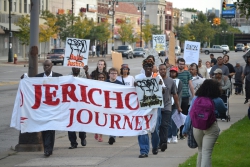Oct
21
2013

Written by Caitlin Endyke
It’s a tale of two cities when it comes to Detroit. While certain pockets of the city that are home to entrepreneurs and the “creative class” continue on a path to revitalization, the rest of the city gets left even further behind. Few issues draw this distinction more clearly than that of Detroit’s transit system. While the Department of Transportation continues to cut budgets for bus routes (the city’s current main form of public transportation), a group of private and public investors is making plans to spend $500 million on a trolley that will make a handful of stops along Detroit’s more affluent neighborhoods as it snakes its way towards the business hub downtown.
The trolley will only run for 3.3 miles with a top speed of no more than 11 miles per hour, making it an inefficient method of transportation even for those who live along its path. In the end, the trolley serves as a $500 million neighborhood beautification project that stands at the expense of Detroiters who rely on an under-funded bus system for daily transportation. To highlight this dichotomy, the North End Woodward Community Coalition, a community-based transit justice organization and longtime BMP partner in Detroit, organized a seven day march through the city to symbolize “how far everyone in the North End including seniors and people with disabilities would have to walk to catch the M1”. The “Jericho Journey” sought to draw parallels to the biblical story of Jacob blowing down Wall of Jericho with the NEWCC tearing down the walls developing between Detroiters who are benefitting from investment and those who are not. “We’re marching for seven days to draw attention to those who depend on Detroit’s crumbling bus system to get to work, school and medical points. They will not be served by the nearly half billion dollars going into the M1 Trolley,” said Reverend Joan Ross of the North End Woodward Community Coalition.
While NEWCC argues that the $500 million to be spent is far from in the public’s interest, they also used the march to highlight further hardships the project’s construction would impose on the thousands of Detroiters who already rely on the buses to get around. The trolley will run along the curb, making tracks dug into the ground a hazard to people using wheelchairs. Cyclists won’t be able to ride along this portion of the road and existing buses will have to be rerouted from the trolley path (which runs along one of Detroit’s main thoroughfares).
Each day of the march, which started September 29 and ended on October 5, focused on a group of people who would be negatively affected by trolley construction and the finished product. An estimated 250 people attended the Journey over the course of the week-long event. Participants noted that they had great support on the streets as they marched, passing out over 2,000 fliers in the neighborhoods they walked through. Local media outlets covered their journey along the way.
NEWCC hopes to garner even more support against the trolley system, advocating for bus riders who want to see more investment in the system they already use every day. The group will host a celebration for a successful march next week. From there they will continue the fight to ensure that all Detroiters have access to good, safe, reliable transportation.
